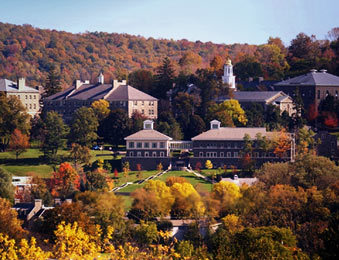Introduction
Just a short drive off of historic Route 20 in upstate New York, travelers are bound to pass by rustic farms, cozy villages, and robust antique fairs. As the Chenango valley opens, visitors find themselves at the doorstep of Colgate University: a beautiful hill crested by the golden dome of the Memorial Chapel, gracefully surrounded by 550 acres of lake, oak lined drives, willow lined footpaths, and sprawling landscapes.
The school was established in 1819, and the academic philosophy is driven by the tradition of a liberal arts core curriculum. This core includes two literary courses about the foundations of Western culture and the post-Enlightenment challenges to Western thought, as well as an in-depth look at a non-Western culture and an exposure to the forefronts of science. While a student is having these academic experiences in a wide range of topics, the school as a research university further challenges students to delve deeply into their major course of study.
The students here love to be challenged, whether as star of the hockey team, double majoring in math and physics with a senior thesis in computational mechanics, or as a creative writing and theatre double major dividing time between a fraternity, Ultimate Frisbee practice, and a volunteer organization working with local children. The students love to be busy, as evidenced by more than 180 student-run organizations coordinated through the Center for Leadership and Student involvement. While students keep the campus calendar alive with performances, lectures, athletic contests, festivals, and parties, the university provides opportunities for reaching out to the surrounding community through the Center for Outreach, Volunteerism, and Education (COVE). The COVE advises groups that tutor, build houses, and build ties with the Hamilton community and beyond, sending spring break groups to New Orleans to assist with Hurricane Katrina relief.
The university continues its connection to a proud history with an active network of successful alumni, who simply love their school, and each year a new class of students with groundbreaking, altruistic, and gregarious ideas continue to further the character of this institution with a strong tradition and an exciting future.





